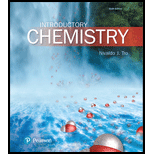
Concept explainers
___________________________________________________
Determine the molecular geometry of each molecule.
(a)
(b)
(c)
(d)
_____________________________________________________
Determine the bond angles for each molecule in problem 65.
Learn your wayIncludes step-by-step video

Chapter 10 Solutions
Introductory Chemistry (6th Edition)
Additional Science Textbook Solutions
Chemistry For Changing Times (14th Edition)
Chemistry: A Molecular Approach (4th Edition)
Organic Chemistry (9th Edition)
Chemistry: An Introduction to General, Organic, and Biological Chemistry (13th Edition)
General, Organic, and Biological Chemistry (3rd Edition)
Chemistry: Structure and Properties (2nd Edition)
- The molecules BF3, CF4, CO2, PF5, and SF6 are all nonpolar, even though they all contain polar bonds. Why?arrow_forwardGiven the bonds C N, C H, C Br, and S O, (a) which atom in each is the more electronegative? (b) which of these bonds is the most polar?arrow_forwardConsider the following molecules: SiH4, PH3, H2S. In each case, a central atom is surrounded by four electron pairs. In which of these molecules would you expect the bond angle to be less than 109.5? Explain your reasoning.arrow_forward
- Nitrosyl azide, N4O, is a pale yellow solid first synthesized in 1993. Write the Lewis structure for nitrosyl azide.arrow_forwardWhich has the greater bond lengths: NO2 or NO3? Explain.arrow_forwardPredict the electron pair geometry and the molecular structure of each of the following:(a) IOF5 (I is the central atom)(b) POCl3 (P is the central atom)(c) Cl2SeO (Se is the central atom)(d) ClSO+ (S is the central atom)(e) F2SO (S is the central atom)(f) NO2−(g) SiO44−arrow_forward
- The compound chloral hydrate, known in detective storiesas knockout drops, is composed of 14.52% C, 1.83% H,64.30% Cl, and 13.35% O by mass, and has a molar massof 165.4 g/mol. (a) What is the empirical formula of thissubstance? (b) What is the molecular formula of this substance?(c) Draw the Lewis structure of the molecule, assumingthat the Cl atoms bond to a single C atom andthat there are a C¬C bond and two C¬O bonds in thecompound.arrow_forwardThe molecule 2-butene, C4H8, can undergo a geometric change called cis-trans isomerization. (Figure 1) Such transformations can be induced by light and are the key to human vision. Rotation about the C=C bond, which breaks the π bond, is required for the isomerization. The average bond energy (enthalpy) for a C=C double bond is 614 kJ/mol and that of a C−C single bond is 348 kJ/mol. Estimate the energy needed to break only the π bond of the double bond of 2-butene.Express your answer numerically in joules per molecule.arrow_forwardB) What is the difference between molarity and formality?arrow_forward
- 3) The molecule diphosphorus tetraoxide (P,O,) has two central atoms and four different resonance structures that do not violate the octet rule. Draw two of these resonance structures below. 4) The compound acetone is a common solvent. It has a chemical formula of CH,COCH, Acetone has three central atoms. (a) Draw the Lewis Dot structure for acetone. (b) Give the Ideal Bond Angle for all three central atoms. 5) Four covalent molecules are drawn below. :o: H. H-CH H H (1) (2) (3) (4) a) Define each of these molecules as polar or non-polar. (1) (2) (3) b) Describe the type of intermolecular force that each molecule would use: (1) (2) (3) (4)arrow_forward19. :O: || :0-N- O: Which of the following statements, if true, would support the claim that the NO3 ion, represented above, has three resonance structures? (A) The NO3 ion is not a polar species. (B) The oxygen-to-nitrogen-to-oxygen bond angles are 90°. (C) One of the bonds in NO3 is longer than the other two. (D) One of the bonds in NO3¯ is shorter than the other two.arrow_forwardWhich of the following bonds are polar: (a) P—O; (b) S—F; (c) Br—Br; (d) O—Cl? Which is the more electronegative atom in each polar bond?arrow_forward
 Chemistry: Principles and ReactionsChemistryISBN:9781305079373Author:William L. Masterton, Cecile N. HurleyPublisher:Cengage Learning
Chemistry: Principles and ReactionsChemistryISBN:9781305079373Author:William L. Masterton, Cecile N. HurleyPublisher:Cengage Learning Chemistry: Principles and PracticeChemistryISBN:9780534420123Author:Daniel L. Reger, Scott R. Goode, David W. Ball, Edward MercerPublisher:Cengage Learning
Chemistry: Principles and PracticeChemistryISBN:9780534420123Author:Daniel L. Reger, Scott R. Goode, David W. Ball, Edward MercerPublisher:Cengage Learning Chemistry for Engineering StudentsChemistryISBN:9781337398909Author:Lawrence S. Brown, Tom HolmePublisher:Cengage Learning
Chemistry for Engineering StudentsChemistryISBN:9781337398909Author:Lawrence S. Brown, Tom HolmePublisher:Cengage Learning General Chemistry - Standalone book (MindTap Cour...ChemistryISBN:9781305580343Author:Steven D. Gammon, Ebbing, Darrell Ebbing, Steven D., Darrell; Gammon, Darrell Ebbing; Steven D. Gammon, Darrell D.; Gammon, Ebbing; Steven D. Gammon; DarrellPublisher:Cengage Learning
General Chemistry - Standalone book (MindTap Cour...ChemistryISBN:9781305580343Author:Steven D. Gammon, Ebbing, Darrell Ebbing, Steven D., Darrell; Gammon, Darrell Ebbing; Steven D. Gammon, Darrell D.; Gammon, Ebbing; Steven D. Gammon; DarrellPublisher:Cengage Learning
 Chemistry: An Atoms First ApproachChemistryISBN:9781305079243Author:Steven S. Zumdahl, Susan A. ZumdahlPublisher:Cengage Learning
Chemistry: An Atoms First ApproachChemistryISBN:9781305079243Author:Steven S. Zumdahl, Susan A. ZumdahlPublisher:Cengage Learning





